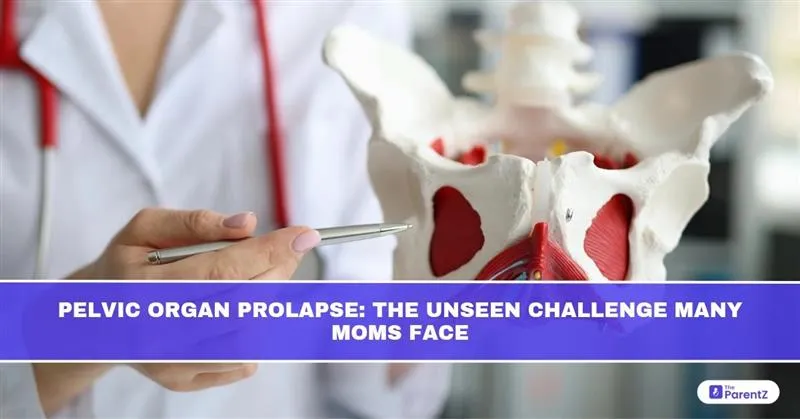The Silent Weight Many Mothers Carry
Motherhood brings joy, pride and often, silent sacrifices. One of those silent struggles that many women never talk about is Pelvic Organ Prolapse (POP).
It doesn’t get the attention it deserves, but POP affects 1 in 3 women at some point, especially after childbirth. It’s not just about discomfort; it can impact everything from bladder control to self-esteem.
What Is Pelvic Organ Prolapse?
Pelvic organ prolapse happens when the muscles and tissues that support the pelvic organs, like the bladder, uterus, or rectum, weaken or stretch. As a result, one or more of these organs drop lower into the vaginal canal. Imagine a hammock that has lost its tension. The organs above no longer sit comfortably and may bulge into the vaginal space. Though not dangerous in itself, prolapse can seriously affect quality of life. But here’s the good news: it can be managed, treated, and often improved.
What Causes It?
While pregnancy and vaginal childbirth are the most common causes, POP can develop due to a combination of factors:
- Stretching of pelvic floor muscles during labour
- Forceps delivery or prolonged second stage of labour
- Multiple pregnancies or closely spaced births
- Chronic coughing, constipation, or heavy lifting
- Menopause, due to a drop in estrogen levels
- Obesity or weak connective tissue (genetics play a role)
It’s important to know that this isn’t about “doing something wrong”, it’s about the very real toll that pregnancy and delivery take on the female body.
How Do I Know If I Have Prolapse?
Pelvic organ prolapse doesn’t always cause symptoms, especially in early stages. But common signs include:
- A feeling of heaviness, dragging, or pressure in the pelvis
- A sensation of something “falling out” of the vagina
- A visible or felt bulge inside the vagina
- Leaking urine or urgency to pee (stress incontinence)
- Difficulty passing stools or a feeling of incomplete bowel movement
- Discomfort during sex
The symptoms may worsen after standing for long hours or at the end of the day, and improve when lying down.
Types of Prolapse
The type depends on the organ affected:
- Cystocele (bladder prolapse): Front wall of the vagina bulges due to bladder descent.
- Rectocele (rectum prolapse): Back wall bulges due to rectum pressing in.
- Uterine prolapse: Uterus slips down into the vaginal canal.
- Enterocele: Small bowel descends into the lower pelvic cavity.
Each type can range from mild (Grade 1) to severe (Grade 4), where the organ protrudes outside the vaginal opening.
Diagnosis: No Shame, Just Support
If you’re experiencing symptoms, talk to your gynecologist or a pelvic floor specialist. Diagnosis typically involves:
- Pelvic exam (sometimes done while you’re standing or bearing down)
- Ultrasound or MRI (in rare or complex cases)
- Bladder function tests if incontinence is present
You don’t need to live with the discomfort. The earlier it’s assessed, the easier it is to treat.
Treatment: From Strengthening to Surgery
1. Lifestyle Changes (for mild cases):
- Avoid heavy lifting
- Manage chronic cough or constipation
- Maintain healthy weight
2. Pelvic Floor Physiotherapy:
Guided Kegel exercises can significantly improve symptoms, especially in the early stages. Working with a trained pelvic physiotherapist helps you target the right muscles effectively.
3. Vaginal Pessary:
A pessary is a silicone device inserted into the vagina to support the organs. It’s non-surgical and especially helpful for those who aren’t ready or suitable for surgery.
4. Hormonal Therapy:
For post-menopausal women, local estrogen creams can improve tissue strength and reduce symptoms.
5. Surgery:
For more severe prolapse or when other treatments don’t help, surgical options include:
- Uterine suspension or hysterectomy
- Repair of the vaginal walls using native tissue or mesh (depending on severity and patient choice)
Surgery is usually effective, but recovery takes time and lifestyle changes are still important afterward to avoid recurrence.
Emotional Impact: It’s Not “Just in Your Head”
Many women with POP feel embarrassed, isolated, or “less feminine.” It may affect body image, relationships, or sexual intimacy. But these feelings are normal and you’re not alone.
A 2022 study in the Journal of Obstetrics and Gynaecology Research found that women with untreated prolapse reported lower self-esteem and relationship satisfaction. The good news? These concerns improve significantly with supportive care and treatment.
Opening up to a doctor, physiotherapist, or even a friend can begin your healing not just physically, but emotionally.
Can I Prevent Prolapse?
While not all cases are preventable, you can lower your risk or slow progression by:
- Doing regular pelvic floor exercises (even before pregnancy)
- Avoiding chronic constipation (hydration and fibre help!)
- Not delaying urination
- Lifting with the legs not the back or core
- Using proper support garments postpartum if recommended
Final Words: You’re Still Whole
Pelvic organ prolapse may be an “unseen” condition, but for many women, its impact is deeply felt. It’s not a sign of weakness, nor is it something you have to silently endure. With awareness, early support, and the right treatment, you can live comfortably and confidently. If your body feels different after motherhood, that’s not failure. That’s reality and help exists.
You’ve brought life into the world. You deserve the same care in return.








Be the first one to comment on this story.